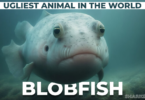Finding Nemo is one of the top-rated animated films in America, produced in collaboration with Walt Disney Pictures, by Pixar Animation Studio. This movie was designed to increase students’ interest in the ocean world. The movie revolves around an overprotective father fish whose son was captured by a fisherman to use them as a part of his aquarium. The movie was a unique way to introduce the new generation to these fishes. Today, in this article I will be explaining which fish is a real counterpart of the top 7 Finding Nemo fishes

Top 7 Finding Nemo Fish in Real Life
These are the top 7 real-life Finding Nemo Fish in reverse order.
7: Spotted Eagle Ray- Mr. Ray
The Nemo’s teacher was a Spotted Eagle Ray, who belongs to the Eagle Ray family of fishes. Its scientific name is Aetobatus narinari, and native fish in tropical regions such as the Indian, Pacific, and Atlantic oceans. This diamond-shaped fish is known for its brownish body, with white spots all over it. It has an average length of 16 feet and can be wide up to 3 feet.

It has downward-faced jaws, but don’t be deceived by its humble looks. The Reason is its tail, which has a poisonous stinger in it. When used, can inflict serious damage to the opponent. This defense mechanism allows them to save themselves from other predators. Although, most sharks still feast upon these rays.
Its food contains other small fish, whelks, and several other marine life. For reproduction, the male and female Spotted Eagle Rays mate, and the female retains the eggs inside her body until they hatch. These rays, due to their big size, are made part of only the public aquariums.
They are gentle fish, with almost no report of any significant attack on any human being. They avoid people due to their shy nature. Their population is consistently declining due to human efforts, making them a threatened species.
6: Yellow Tang- Bubbles
A bubble-obsessed fish in Finding Nemo, Bubble is a Yellow Tang fish in real life. Its Scientific name is Zebrasoma Flavescens and located near the reefs of the Hawaiian region and also on the coasts of the Pacific Oceans. This fish has a very distinct yellow color body, with a mouth similar to a snout pointing a little bit downwards differentiates them from other fishes. They have an approximate size of 20 cm.

Its food is mainly based on the algae, which it can easily feast upon using its special mouth. They lay and fertilize their eggs in open water, known as spawns that happen throughout the year. Once spawns are placed, they are not guarded by any parents, even after hatching.
The small size of the Yellow Tang makes it perfect for aquariums. In water bodies, its natural predators include most of the bigger fishes like crabs, sharks, and a couple of others. Human activities are having severe effects on the health of Yellow Tangs.
Fun Fact: The egg reproduction cycle in Yellow Tang is related to the moon cycle.
5: Starfish- Peace
The real star of the show Finding Nemo, Peach is a Starfish in the actual world. It belongs to the scientific class Asteroidea and has over 1900+ species found inside all kinds of oceans. They are also commonly known as asteroids, basket stars, or brittle stars. This is because they look like an actual star with all 5 limbs acting as the 5 sides of the star.

The starfish based on the species, can reproduce through sexual or asexual reproduction. In the case of sexual reproduction, both males and females reproduce by fertilizing their eggs in water. While in Asexual reproduction, they often reproduce using fission(dividing into multiple parts, which grow into new organisms).
Starfish can have an average weight of 20 to 800g and a life of around 34 years. They are preyed on by bigger sea animals including seagulls and even human beings. It is a popular street food item in Indonesia, China, and Thailand.
4: Great White Shark- Bruce
This evil character in the movie Finding Nemo was a replication of a Great White Shark. Its scientific name is Carcharodon carcharias and found in the temperate regions of the ocean. They are classified as the biggest living fish out there, often seen near the Mexico Gulf and nearby oceans. They have an average size of 15 to 16 feet.

They reproduce by mating and female keep the eggs inside their body(the process known as ovoviviparous). A shark can take 11 months to develop the egg into a whole baby shark. They prey upon most of the fishes including fish, dolphins, and many more. They are now classified under the vulnerable species category.
(For more details about sharks, click here)
3: The Moorish Idol- Gill
The leader of the fish tank fishes in Finding Nemo, Gill is an actual Moorish Idol fish. Its scientific name is Zanclus Cornutus and is found in most of the tropical Pacific, Red Sea, and Indian Ocean. It belongs to the ray-finned fish family, with a disc-like body, stripes, and a snout-shaped mouth, it is widely available fish around the globe. They have small bristle-shaped teeth inside their mouth.

It has an average size of 8 to 9 inches and often roam around in a group of 2 or 3 fish. They are also often found in the form of a school(a group of fish is called a school) of fish. They feed small invertebrates corals and similar living beings to survive.
2: Blue Hippo Tang- Dory
The forgetful and optimistic Dory is a Blue Hippo Tang fish in real life. The scientific name is Paracanthurus Hepatus and located in the Indo-Pacific region of the world. It is commonly known as the surgeonfish and has a characteristics royal blue body with yellow fins and tails. Right now, it is not considered endangered, but it is slowly moving on the same path most of the extinct and endangered species have gone down.

It is a poisonous fish, so can not be consumed by humans. But, it is a great bait fish due to its pungent and popping color to attract the lure. It is an omnivorous fish, which means it can eat living things other than small invertebrates and can consume algae.
1: The Clownfish- Nemo and Marlin
The main heroes of the movie Finding Nemo, both Nemo and Marlin are the real-life Clownfish. The Clownfish, scientifically named Amphiprioninae, is found in the regions of warm water. Other than the Atlantic, it is available in most of the regions, living near the bottom surface of the sea. The region includes the Pacific Ocean, the Red Sea, and other similar areas.
The Clownfish has a distinct orange color with white and black stripes designs on it. This makes it much more desirable to be added to the aquarium by the sea lovers. It also has multiple color variants based on the region and species type.

They have a size of 5 to 8 cm and are also known as anemonefish. The reason is because of the symbiotic and mutualistic relationship of Clownfish with the sea anemone. The clownfish eat the undigested food of an anemone and in return send his focus there so that anemone consumes it.
The Clownfish is one of its kind, as all of the fishes are male by birth. In a group, there is a dominant, big, aggressive female and the rest of the Clownfish are male ones. The biggest male Clownfish will automatically turn into a female, once the female dies.
During the reproduction phase(which can happen the whole year), the female lays hundreds of eggs, and then all the males around them will fertilize them. If there is any damaged or spoiled egg, the male Clownfish will simply eat them.
Primary only the male Clownfish helps to take care of eggs and newly hatched fry. The female does help them sometimes though. Once a male fish is turned into a female, it will stay like this forever.
Fun Fact: Anemone is a poisonous living thing, but it still does not have any impact on the Clownfish it hosts.
Conclusion
Finding Nemo was a wonderful movie, that actually made realize the children about the life cycle of different marine animals. These fishes inspired by these real-life counterparts were a great way to provide knowledge to the audience. This article targets the audience to have an even better insight about these fish, they used to love back in the day. It allows them to refresh their memory and be able to understand the life of their top 7 Finding Nemo fish in real life and in a better way.







